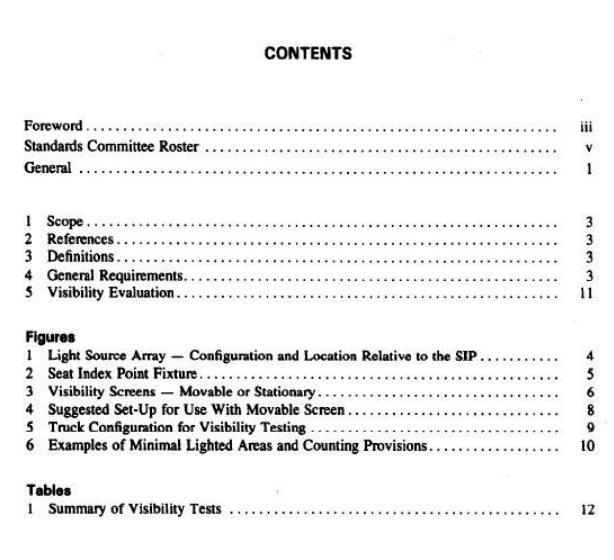ASME B56.11.6:1992 pdf free download Evaluation of Visibility from Powered Industrial Trucks
1 sCOPE
This Standard establishes the conditions, procedures,equipment ,and acceptability criteria for evaluating vis-ibility from powered industrial trucks.It applies to in-temal combustion engine powered and electric high lift,counterbalanced, sit-down rider industrial trucks up toand including 10 000 kg (22,000 lb) capacity.
Visibility is evaluated by using an array of lamps,centered at the theoretical eye level of a seated operator,and observing light and shadow areas on a vertical screenin specific locations around the truck.The light sourcearray simulates the normal range of position of the seatedoperator’s eyes with typical head movement.The lightand shadow areas describe what can and can not be seenby the operator.Traveling mode visibility is evaluatedwith the screen 4000 mm (157.48 in.) to the front ofand to the rear of the truck.For maneuvering mode vis-ibility, the screen is positioned at 1200 mm (47.24 in.)from the truck to the front,rear,and both sides. Ac-ceptable visibility is based on measurements of darkshadows cast on the screen in each of the test condi-tions.
2 REFERENCES
2.1 International Organization for
Standardization
ISO 5353-1978 (E), Earth-Moving Machinery -Seatlndex Point
ISO/TC110/sC2 N 258.Draft proposalApril 1982,Powered Industrial Trucks- Visibility Test Methodsand Requirements
DEFINITIONs
Refer also to terminology in Appendix B of ASME/ANSI B56.1.
acceptable visibiliry – test results from a complete se-ries of tests conducted in accordance with this volumewhich meet or exceed the acceptability criteria estab-lished for each test condition dark shadow – an area on the screen which is not di-rectly illuminated by any of the lamps of the light sourcearray
light area – an area on the screen which is directly il-luminated by at least one lamp on the light source arraylight source array — a device,consisting of 26 lampsconfigured as shown in Fig. 1.used to provide light fromthe range of positions of the operator’s eyes to a screen.The light source array can be rotated to five positions,as shown in Fig.L, to evaluate visibility to the front,rear, left, and right.
maneuvering – refers to precise movement of the truckas it is being used to move materials. or passing objectsclose by, at slow speeds
operator’s eye level – a theoretical horizontal plane at650 mm (25.59 in.) above the SIP. representing an av-erage operator
screen – a flat vertical surface used to measure lightareas and dark shadows for the tests in this volume.Alarge stationary screen, sketch(a) of Fig. 3, or a smallermovable screen, sketch (b) of Fig. 3, may be used. Thesurface should be white or light in color and it is advis-able to mark it in 100 mm (3.94 in.) squares.
Seat Index Point 《SIP)- a specific point relative to theoperator’s seat.The SIP is determined by using the ScatIndex Point fixture, Fig. 2.
Seat Irdex Point fxture – a device uscd to dele minethe SIP and to locate the light source array for this vis-ibility standard. it is confgured as shown in Fig. 2.Alsorefer to ISO 5353-1978.Earth-Moving Machinery -Seat Index Point.
traveling – movement of the truck over relatively longdisuance and open areas at faster speeds than maneuver-ing
4 GENERAL REQUIREMENTS4.1 Test Facility
The visibility tests should be conducted in an areawhere all other sources of light can be eliminated andonly light from the light source array shines on the screen
ASME B56.11.6:1992 pdf free download
